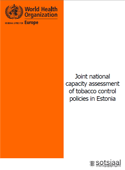Joint national capacity assessment of tobacco control policies in Estonia

Download
Estonia ratified the WHO Framework Convention on Tobacco Control within five months after it entered into force in 2005. In the same year, the Riigikogu (parliament) passed into law the Tobacco Act to comply with the Convention and current European Directives on tobacco.
The National Health Plan, the National Strategy for the Prevention of cardiovascular Diseases and the National Cancer Strategy articulate the case for reducing tobacco use, and research generated both in Estonia and internationally supports the case.
Evidently, in the mid-2000s, Estonia was making progress in developing tobacco control policy based on years of experience in developing smoking-cessation services as an integral part of the national health system. Nevertheless, the advances that were made during that time have not yet been translated into significant reductions in smoking prevalence – except among university educated Estonians. Overall, the smoking prevalence rose from the early to mid-1990s. That trend was reversed in the late 1990s, however, and by 2008, the prevalence was less than 1.5 percentage points lower than it was in 1990 while, during the same period, the smoking prevalence in Finland declined by 6 percentage points and in England by 8 percentage points.
Of particular concern is that the smoking prevalence among Estonians with less education is worse now than it was in the mid-1990s, thereby increasing social inequality and inequality in health. The smoking prevalence among teenagers rose quite sharply in the late 1990s and has started to decline, except among mid-teenage girls. Smoking in pregnancy has steadily increased over the last decade. Both trends will result in health problems for infants and children and for young adult women.
In this context, at the request of Estonia’s Ministry of Social Affairs, a mission led by WHO conducted a joint rapid assessment of current practices and national capacity for tobacco control in Estonia. The WHO Regional Office for Europe worked together with the Public Health Department of the Ministry of Social Affairs and with the National Institute for Health Development to organize and conduct this capacity assessment.



